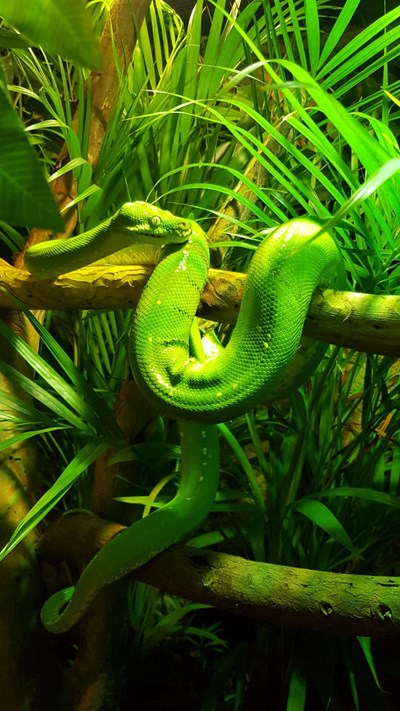Green Tree Python
Green Tree Pythons have a relatively large head and eyes, as well as a scattering of white spots over their body. Green Tree Pythons are primarily a rainforest species but have been observed in banana plantations, their diet consists of mammals, birds, small skinks, geckos & frogs. Green Tree Pythons grow to 1.4 - 1.8 metres in length and weigh up to 1.4kg.
Green Tree Pythons are non-venomous species, to subdue their prey they have a couple of unique hunting techniques. In the wild, this bright green python is often observed curled up on a tree branch with its head in the middle, by curling up they don't look much like a snake - which can give them the element of surprise when prey are nearby. The tip of their tail is a different colour from their the rest of their body, and they use this as a lure to bring their prey directly within their strike range.

Snake safety
While the Green Tree Python is not considered a dangerous species (as they are non-venomous), it is still important to be safe. Should you come across one outdoors, be sure to keep your distance. If you spot a snake - back away slowly, and most importantly, never pick up or attempt to move a snake.

Sonny taking a sip!
In the wild, Green Tree Pythons can collect droplets of water on their skin when it rains. This makes a quick drink nice and easy - watch the video to check this out!
More photos

Sonny curled up
By curling up they don't look much like a snake, which can give them the element of surprise when prey are nearby.

Sonny looking around

Sonny showing off his side-profile

Sonny as a juvenile
Aka. "Noodle Jnr."
Conservation status

Potential threats
- Collection from the wild despite being illegal (Pet trade)
- Over-harvesting of certain sub-populations (Genetic diversity)
Date assessed: 12 June 2017
Morelia viridis has been assessed as Least Concern. It has a widespread distribution through New Guinea its associated offshore islands and northeast Australia. It is abundant throughout the majority of its range, inhabits a wide range of closed forest habitats, and is not thought to be declining sufficiently rapidly across its range as a whole to qualify for listing in a threatened category. It is present in many protected areas in New Guinea and Australia. Despite wild harvest being illegal it is one of the more commonly traded reptile species in Indonesian New Guinea. This may not be affecting the species as a whole but the harvest of M. viridis may threaten some localized populations and in particular, those on isolated islands. Of highest concern is the subpopulation on Biak Island in Papua Province, Indonesian New Guinea.
IUCN Red List